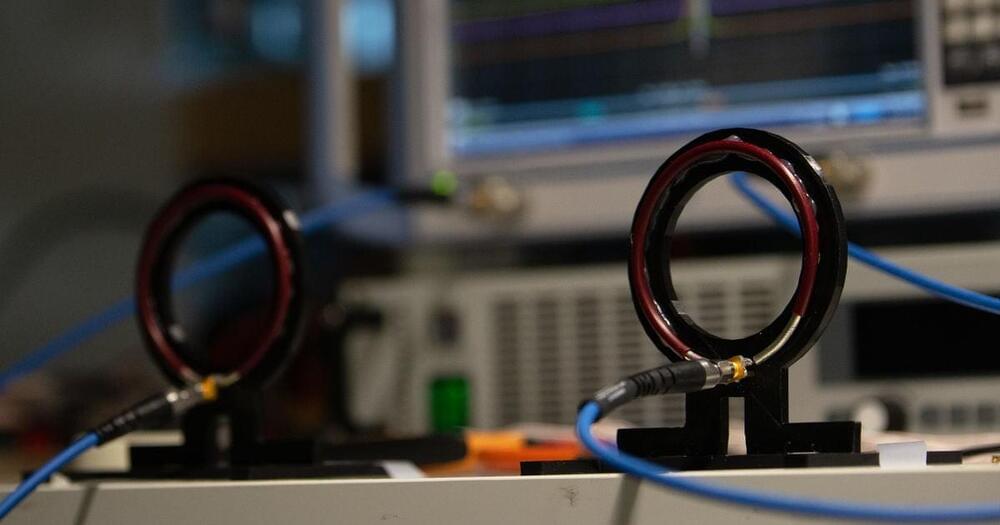The Quantum Insider (TQI) is the leading online resource dedicated exclusively to Quantum Computing.



A better way to wirelessly charge over long distances has been developed at Aalto University. Engineers have optimized the way antennas transmitting and receiving power interact with each other, making use of the phenomenon of “radiation suppression”. The result is a better theoretical understanding of wireless power transfer compared to the conventional inductive approach, a significant advancement in the field.
Charging over short distances, such as through induction pads, uses magnetic near fields to transfer power with high efficiency, but at longer distances the efficiency dramatically drops. New research shows that this high efficiency can be sustained over long distances by suppressing the radiation resistance of the loop antennas that are sending and receiving power. Previously, the same lab created an omnidirectional wireless charging system that allowed devices to be charged at any orientation. Now, they have extended that work with a new dynamic theory of wireless charging that looks more closely at both near (non-radiative) and far (radiative) distances and conditions. In particular, they show that high transfer efficiency, over 80 percent, can be achieved at distances approximately five times the size of the antenna, utilizing the optimal frequency within the hundred-megahertz range.
‘We wanted to balance effectively transferring power with the radiation loss that always happens over longer distances,’ says lead author Nam Ha-Van, a postdoctoral researcher at Aalto University. ‘It turns out that when the currents in the loop antennas have equal amplitudes and opposite phases, we can cancel the radiation loss, thus boosting efficiency.’
Examining the view that mind and body are separate substances.
Note at 7:08 A reductio ad absurdum argument (one which attributes a machine with thought purely for the sake of argument, to demonstrate that genuinely absurd / contradictory consequences follow) would be valid. We can see immediately that Plantinga’s thought experiment doesn’t achieve this: failure to discern how a thinking machine is thinking indicates only lack of comprehension, not a genuine absurdity / contradiction.
But his use of Leibniz’ scenario isn’t valid. Leibniz doesn’t just propose a thinking machine, but one we can enter and inspect. If physical thinking things are impossible — as Plantinga claims — then whatever machine we conjure up in our imagination to enter and inspect, it can’t be a genuine physical thinking thing, just as it would be impossible to inspect a machine that prints square circles. (Besides, if there’s truly nothing we could be faced with inside the machine that would signal thought, it makes no sense to ask us to inspect it, since no inspection could help us discern thinking machines from non-thinking ones anyway.) It is this sense in which Plantinga cannot use thinking machines to show machines can’t think. His argument is incoherent. It is certainly not a valid reductio ad absurdum.
Selected Resources:
Humanoid robot Asimo demonstration:
Descartes, R — Discourse on the Method (1637)

Until the early 20th century, the question of whether light is a particle or a wave had divided scientists for centuries. Isaac Newton held the former stance and advocated for his “corpuscular” theory. But by the early 19th century, the wave theory was making a comeback, thanks in part to the work of a French civil engineer named Augustin-Jean Fresnel.
Born in 1,788 to an architect, the young Fresnel had a strict religious upbringing, since his parents were Jansenists — a radical sect of the Catholic Church that embraced predestination. Initially he was home-schooled, and did not show early academic promise; he could barely read by the time he was eight. Part of this may have been due to all the political upheaval in France at the time. Fresnel was just one year old when revolutionaries stormed the Bastille in 1,789, and five when the Reign of Terror began.
Eventually the family settled in a small village north of Caen, and when Fresnel was 12, he was enrolled in a formal school. That is where he discovered science and mathematics. He excelled at both, so much so that he decided to study engineering, first at the École Polytechnique in Paris, and then at the École Nacionale des Ponts et Chaussées.
The ability to get a strike force anywhere and fast is of vast strategic value, and the future may dropships landing anywhere on a planet within minutes.
Visit our Website: http://www.isaacarthur.net.
Checkout this episode ad-free on Nebula: https://nebula.tv/videos/isaacarthur-dropships-drop-pods.
Support us on Patreon: https://www.patreon.com/IsaacArthur.
Support us on Subscribestar: https://www.subscribestar.com/isaac-arthur.
Facebook Group: https://www.facebook.com/groups/1583992725237264/
Reddit: https://www.reddit.com/r/IsaacArthur/
Twitter: https://twitter.com/Isaac_A_Arthur on Twitter and RT our future content.
SFIA Discord Server: https://discord.gg/53GAShE
Listen or Download the audio of this episode from Soundcloud: Episode’s Audio-only version: https://soundcloud.com/isaac-arthur-148927746/dropships-drop-pods.
Episode’s Narration-only version: https://soundcloud.com/isaac-arthur-148927746/dropships-drop-pods-narration-only.
Credits:
Dropships & Drop Pods.
Episode 405, July 27, 2023
Written, Produced & Narrated by:
Isaac Arthur.
Editors:
David McFarlane.
Konstantin Sokerin.
Graphics:


A European satellite is making a first-of-its kind return to Earth this week.
The European Space Agency (ESA) is currently guiding its Aeolus wind-studying satellite down for a controlled destruction in Earth’s atmosphere. This strategy is a major shift for Aeolus, whose original end-of-life plan called for an unguided fall.

Scientists at the University of Arizona are counting down the days until a space probe carrying samples from an asteroid is back on Earth. FOX 10’s Steve Nielsen has more on the OSIRIS-REx mission, and why the samples are so important for researchers.
Of the 250 grams of samples, NASA officials will keep 75% of the samples in storage for future generations, whom might discover ways to test the rocks in ways we can’t even comprehend.
The secrets the samples hold could be endless.

Aditya L1 is India’s first space-based mission to study the Sun, which is scheduled to be launched in 2023. The spacecraft is named after Aditya, the Hindu god of the Sun. Indian Space Research Organisation (ISRO) aims to place Aditya L1 in a halo orbit around the Sun-Earth L1 Lagrange point, which is about 1.5 million kilometres from Earth.
The mission’s primary objective is to study the Sun’s corona, which is the corona is a very hot and dynamic region. Aditya L1 will carry a number of instruments to study the corona, including a coronagraph, a spectrometer, and an imager.
